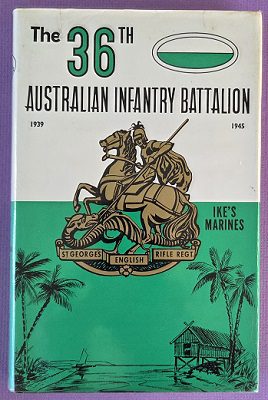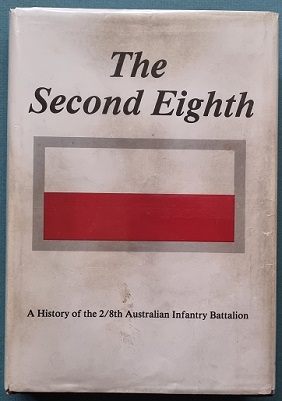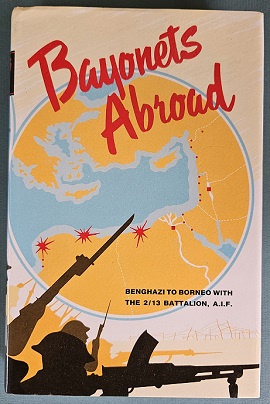Description
Title: The 36th Australian Infantry Battalion, 1939 – 1945
Author: Brigg, Stan and Brigg, Les
Condition: Very Good Plus – Page block is discoloured.
Edition: 1st Edition
Publication Date: 1967
ISBN: Nil
Cover: Hard Cover with Dust Jacket – 210 pages
Comments: This is a second-hand book
The history of the 36th Infantry Battalion (St George English Rifle Regiment) during World War 2.
After the First World War the defence of the Australian mainland lay with the part-time soldiers of the Citizens Military Force (CMF), also known as the Militia. The Militia was organized to maintain the structure of the First AIF and kept the same numerical designations. The Militia units were distributed in the same areas the original AIF units were raised. Thus, Sydney’s 36th Infantry Battalion was the “St Georges English Rifle Regiment”. The 36th was formed at Ashfield in 1921 and four years later moved its headquarters to the neighbouring suburb of Haberfield. During the inter-war period the battalion came under the command of notables, such as Leslie Morshead and Arthur “Tubby” Allen.
With start of the Second World War, the battalion recruited heavily from the areas around Haberfield and Leichhardt and entered camp at Rutherford for one month of training. Throughout 1940 and 1941 more training camps followed at Rutherford, Greta, and Bathurst. Following Japan’s entry into the war, the 14th Brigade, comprising the 36th, 3rd, and 55th Battalions, moved to the coast to defend Newcastle in March 1942. With its headquarters in Gan Gan the 36th was deployed along the beaches from Anna Bay, near Newcastle Bight, to Nelson’s Bay, in Port Stephens. After several weeks the 14th Brigade returned to Greta in preparation for its transfer to Townsville and Port Moresby in May 1942. Except for four short months, the 36th served in New Guinea and New Britain until June 1945, under the command of Lieutenant Colonel Oscar “Ike” Isaachsen.
While in Moresby the battalion carried out garrison duties, later conducting long-range patrols in the Owen Stanley Range. With the Japanese fighting across the Kokoda Trail, the 36th moved to Koitaki in the Owen Stanley’s in September. The Japanese had reached Nauro, from where a track ran south to Subitana, connected by road to Moresby. It was feared the Japanese would take the alternate route, instead of the steeper track at Ower’s Corner, and the 36th was sent to block any such attempt. The 36th patrolled the area for about a week, before it was sent further up the track to Uberi, where they relieved the remnants of the 2/14th and 2/16th Battalions. On 9 October the 36th left the track and returned to Port Moresby.
Although the 36th had returned to Port Moresby, the Australians continued to push the Japanese back along the Kokoda Trail, attacking heavily defended positions in Buna, Gona, and Sanananda. After bitter fighting, Buna and Gona were captured and the Australians attacked Sanananda. The 16th Brigade made the first attack with little headway. Consequently, the 30th Brigade, comprised of the 49th, 55th/53rd, and 36th Battalions, joined the assault.
The 49th and 55th/53rd made an unsuccessful attack on Sanananda on 7 December, before the 36th arrived. In another attempt on 19 December the 36th contained the Japanese front, while the 49th and the 55th/53rd attacked on either side. Again, the attack failed but fighting continued for days. On 24 December two companies from the 36th moved back behind the lines, with one company remaining in the front line.
On 26 December the 36th again attacked Sanananda but, after several days of fierce fighting, the Australians still could not capture the Japanese positions. Sanananda was not completely captured and cleared until 21 January 1945, by which time the 14th Brigade and the 36th had been transferred. The 36th would never again experience combat as intense or prolonged. By the end of 1942 the 36th was reduced to just 16 officers and 272 men – halved in a fortnight.
At the start of January 1943, the 36th moved to the Gona area to relieve the 55th/53rd and patrol the Gona–Amboga River area. In March 1943 the 36th returned to Australia and, after a short period of leave and training in northern Australia, returned to New Guinea in July. For the next 15 months the 36th was stationed in Port Moresby, Soputa, Buna–Oro Bay, Lae, Wau, and Bulolo.
In October 1944 the battalion moved by sea to the north coast of New Britain, later joined by the 14th/32nd and 19th Battalions of the 6th Brigade. Rather than carry out a major offensive against the Japanese at Rabaul, the much smaller Australian force confined the Japanese to the Gazelle Peninsula with active patrolling. For the next seven months the 36th made a name for itself with long-range patrols and numerous amphibious landings, becoming known as “Ike’s Marines”.
In June 1945 the 36th was relieved and brought back to Australia. Its final parade was on 27 August, and the battalion was disbanded shortly after.
Nominal Roll included




